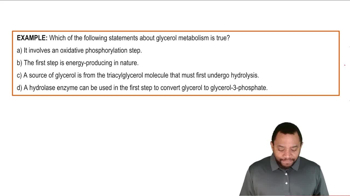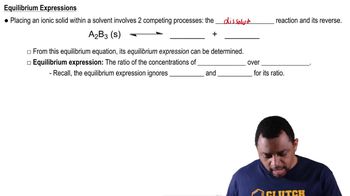How is cholesterol transported around the body? When it leaves the liver, what is its destination and use?
Ch.24 Lipid Metabolism
Chapter 24, Problem 24.32
How many molecules of acetyl-CoA result from catabolism of 1 molecule of glyceryl trilaurate?
(Hint: See Worked Example 24.3 and don’t forget glycerol.)
 Verified step by step guidance
Verified step by step guidance1
Identify the structure of glyceryl trilaurate, which is a triglyceride composed of glycerol and three lauric acid molecules.
Understand that during the catabolism of triglycerides, the fatty acids are released from the glycerol backbone through hydrolysis.
Recognize that each lauric acid (a 12-carbon fatty acid) undergoes beta-oxidation to produce acetyl-CoA molecules.
Calculate the number of acetyl-CoA molecules produced from one lauric acid by dividing the number of carbons in lauric acid by 2, since each acetyl-CoA contains 2 carbons.
Consider the glycerol backbone, which can be converted into dihydroxyacetone phosphate and then enter glycolysis, eventually leading to the production of additional acetyl-CoA.

Verified Solution
Video duration:
2mWas this helpful?
Key Concepts
Here are the essential concepts you must grasp in order to answer the question correctly.
Glyceryl Trilaurate Catabolism
Glyceryl trilaurate is a triglyceride composed of glycerol and three lauric acid (C12) fatty acid chains. During catabolism, it undergoes hydrolysis to release glycerol and free fatty acids, which are then further broken down through beta-oxidation to produce acetyl-CoA. Understanding this process is crucial for determining the total acetyl-CoA yield from one molecule of glyceryl trilaurate.
Recommended video:
Guided course

Glycerol Metabolism Example 1
Beta-Oxidation
Beta-oxidation is the metabolic process by which fatty acids are broken down in the mitochondria to generate acetyl-CoA. Each cycle of beta-oxidation shortens the fatty acid chain by two carbon atoms, producing one molecule of acetyl-CoA per cycle. For glyceryl trilaurate, the number of cycles depends on the total number of carbon atoms in the fatty acids released.
Recommended video:
Guided course

Beta Decay Example 1
Acetyl-CoA Production
Acetyl-CoA is a central metabolite in energy production and biosynthesis, formed from the breakdown of carbohydrates, fats, and proteins. In the context of fatty acid catabolism, each acetyl-CoA produced can enter the citric acid cycle for ATP generation. The total number of acetyl-CoA molecules produced from glyceryl trilaurate is essential for understanding its energy yield and metabolic fate.
Recommended video:
Guided course

Solubility Product Constant (Ksp) Concept 2
Related Practice
Textbook Question
17
views
Textbook Question
The glycerol derived from lipolysis of triacylglycerols is converted into glyceraldehyde 3-phosphate, which then enters into step 6 of the glycolysis pathway. What further transformations are necessary to convert glyceraldehyde 3-phosphate into pyruvate?
7
views
Textbook Question
How are long-chain fatty acids released from triacylglycerides transported through the bloodstream?
32
views
Textbook Question
Why is the stepwise oxidation of fatty acids called ß oxidation?
43
views
Textbook Question
Arrange these following four molecules in increasing order of their biological energy content (per mole):
a. Sucrose
b. Myristic acid, CH₃(CH₂)₁₂COOH
c. Glucose
d. Capric acid, CH₃(CH₂)₈COOH
17
views
Textbook Question
Write the equation for the final step in the catabolism of any fatty acid with an even number of carbons.
16
views
